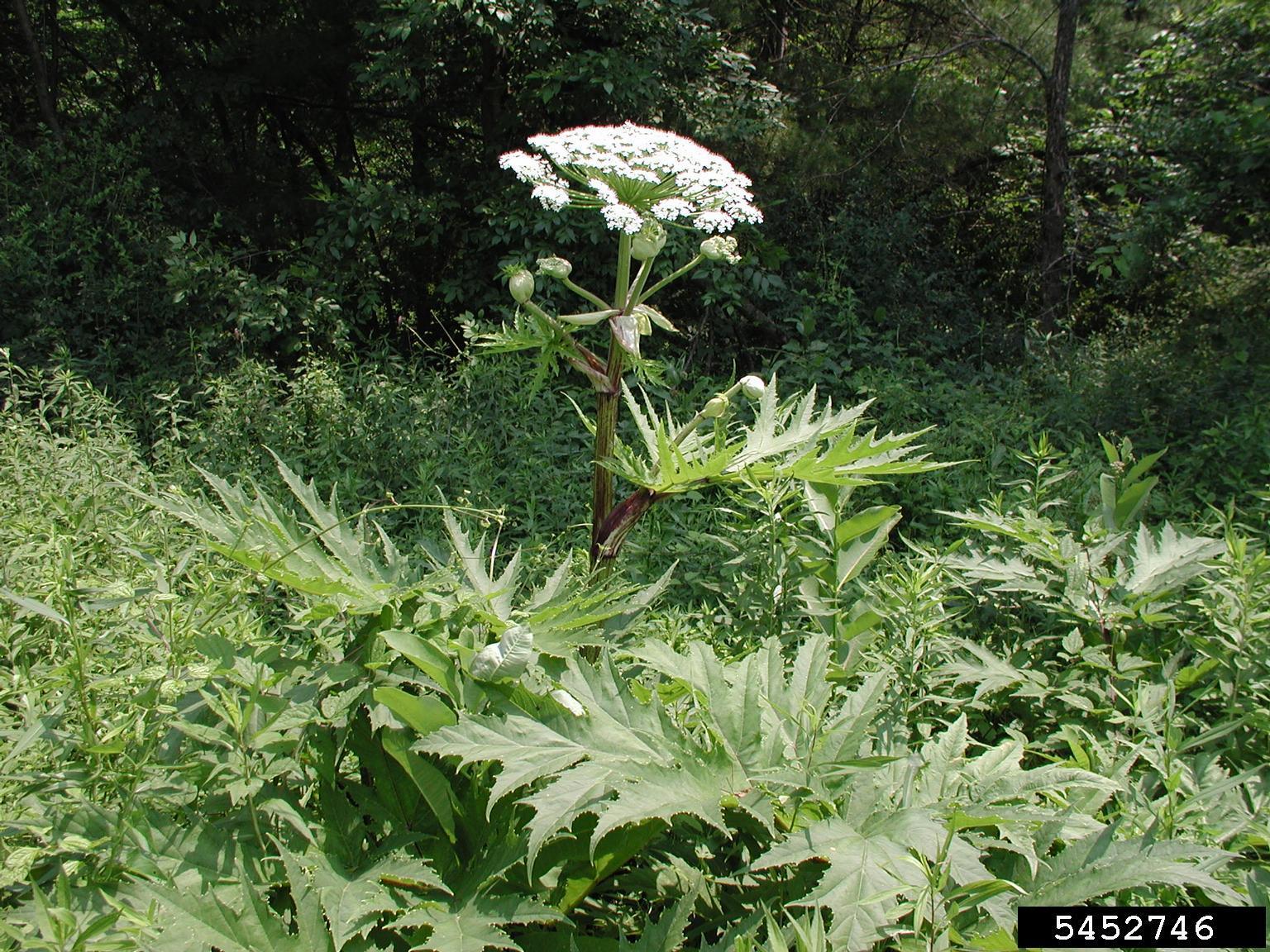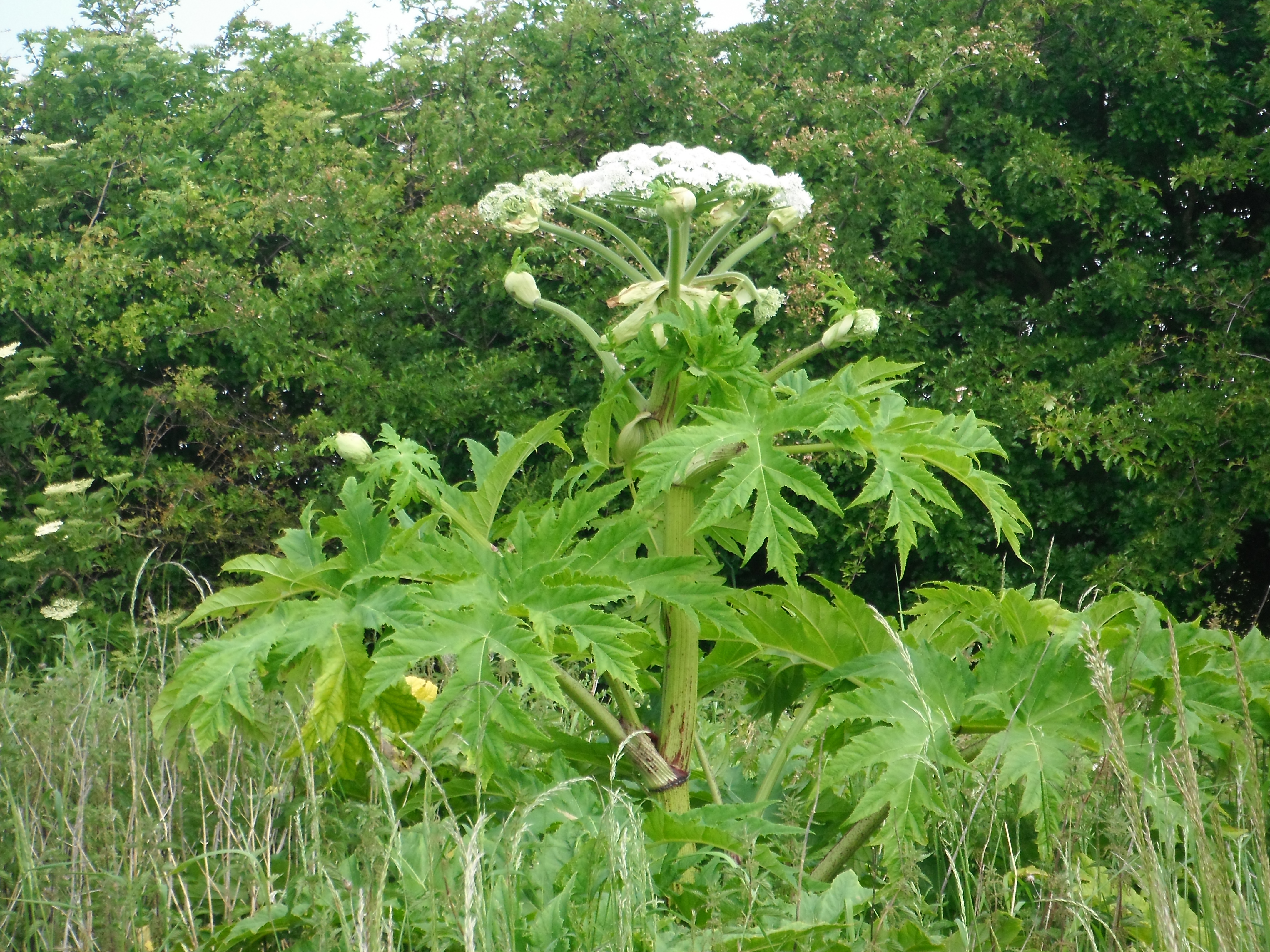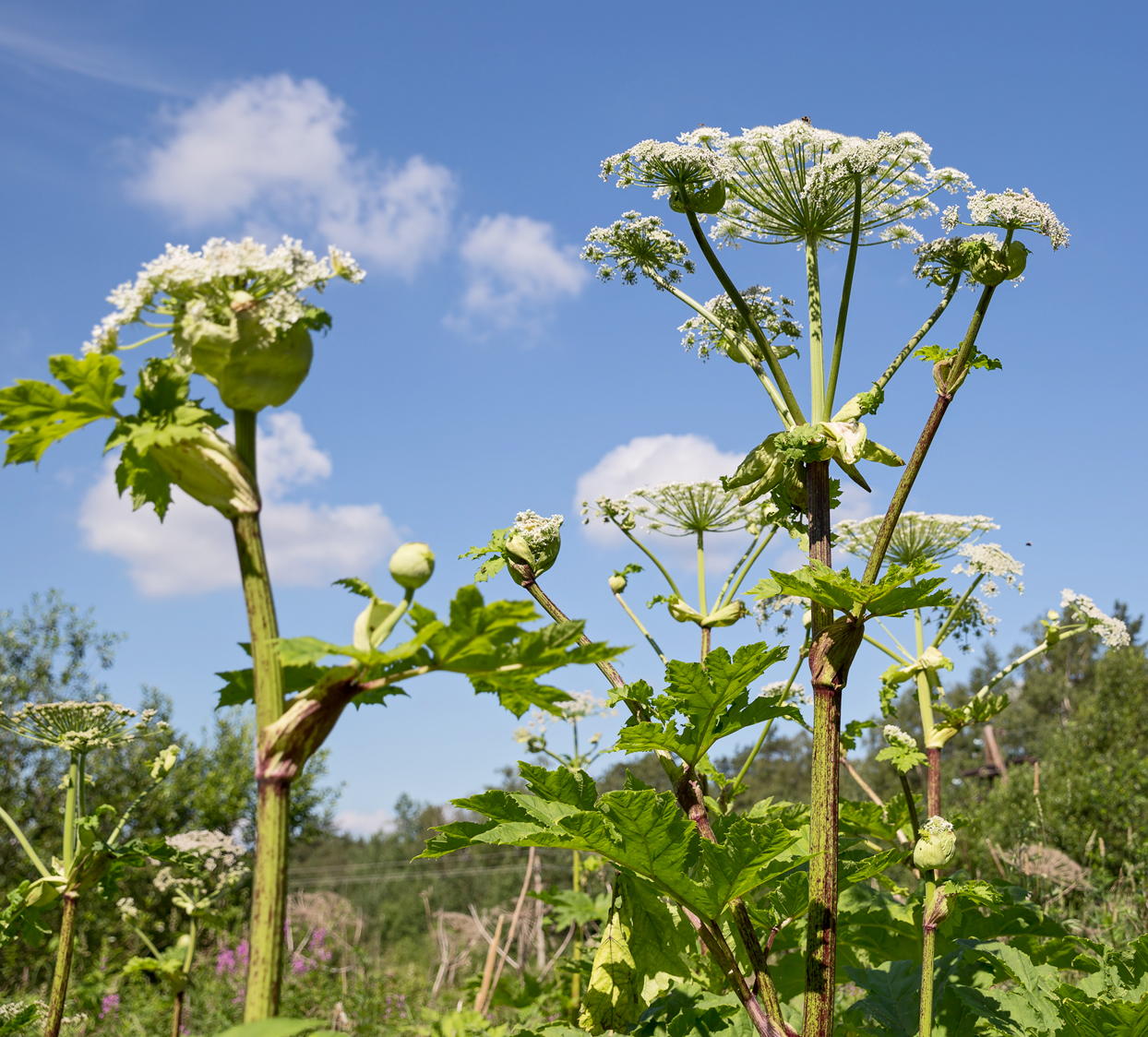Botanical Characteristics
Giant hogweed (Heracleum mantegazzianum) is a colossal herbaceous plant belonging to the Apiaceae family. Its imposing presence and distinctive features set it apart from other plant species.
Amidst the towering stalks of giant hogweed, a tale unfolds that echoes far beyond its toxic embrace. As the world grapples with the enigma of the iran president missing , the ominous shadow of this invasive plant looms large. Its sap, a potent poison, whispers secrets that intertwine with the silence surrounding the missing leader.
The fate of one hangs in the balance, while the other continues its relentless march, leaving a trail of mystery and unease in its wake.
The plant’s most striking characteristic is its exceptional height. Giant hogweed can reach towering heights of up to 15 feet (4.5 meters) or more, with a stout, hollow stem that supports its massive foliage and inflorescence.
Leaves
The leaves of giant hogweed are equally impressive. They are large and deeply divided into leaflets, resembling a spread-out hand. Each leaflet is coarsely serrated and can measure up to 3 feet (0.9 meters) in length. The leaves are arranged alternately along the stem, forming a dense canopy that intercepts sunlight.
Stems
The stem of giant hogweed is thick and hollow, adorned with coarse bristles or hairs. These hairs are a distinctive feature of the plant and can cause severe skin irritation if touched.
Flowers
Giant hogweed produces massive, umbrella-shaped flower heads that can reach a diameter of up to 2 feet (0.6 meters). The flower heads are composed of numerous tiny white flowers that bloom in mid to late summer.
Roots
The root system of giant hogweed is extensive and consists of a large, fleshy taproot. The taproot can penetrate deep into the soil, providing the plant with a secure anchor and access to water and nutrients.
Unique Features
Giant hogweed possesses several unique features that distinguish it from other plants. The combination of its towering height, large, divided leaves, bristly stem, and massive flower heads makes it an unmistakable species.
The presence of toxic sap in the plant’s stems and leaves is another distinctive characteristic. This sap can cause severe burns and blisters upon contact with skin, especially when exposed to sunlight.
Habitat and Distribution
Giant hogweed thrives in moist, nutrient-rich soils, often found along riverbanks, ditches, and roadsides. Its adaptability allows it to colonize various habitats, including forests, grasslands, and urban areas.
Giant hogweed, an invasive species known for its towering stature and toxic sap, has been spreading rapidly across the globe. The plant’s presence has raised concerns similar to those surrounding the iran president is dead incident, where misinformation and fear can quickly overshadow the truth.
As with any potential threat, it is crucial to separate fact from fiction and rely on credible sources for accurate information regarding giant hogweed’s risks and proper handling.
Factors Contributing to Spread and Invasiveness
- Wind Dispersal: Giant hogweed’s lightweight seeds are easily dispersed by wind, facilitating its spread over long distances.
- Water Dispersal: Seeds can be transported by water currents, allowing the plant to establish in new areas along waterways.
- Human Activity: Unintentional introduction through contaminated soil or plant material contributes to its spread in new regions.
- Lack of Natural Predators: Giant hogweed lacks natural predators in many areas, giving it a competitive advantage over native species.
Geographic Prevalence, Giant hogweed
Giant hogweed is native to the Caucasus region and has become invasive in numerous countries worldwide, including:
- Europe: United Kingdom, Ireland, France, Germany, Poland
- North America: United States, Canada
- Asia: Japan, South Korea
- New Zealand
Medicinal and Traditional Uses
Throughout history, giant hogweed has been employed in various cultures for its purported medicinal properties. Its traditional uses range from treating wounds and skin ailments to alleviating pain and inflammation.
Medicinal Properties
Giant hogweed contains several compounds with potential medicinal benefits, including:
- Furanocoumarins: These compounds have antibacterial, antiviral, and antifungal properties.
- Polysaccharides: These compounds have antioxidant and anti-inflammatory effects.
- Flavonoids: These compounds have antioxidant and anti-inflammatory properties.
These compounds have been attributed to various therapeutic effects, including:
- Antibacterial activity
- Antifungal activity
- Anti-inflammatory activity
- Wound healing
- Pain relief
Traditional Healing Practices
Giant hogweed has been incorporated into traditional healing practices in various cultures:
- In traditional Chinese medicine, giant hogweed is used to treat wounds, burns, and skin infections.
- In Ayurvedic medicine, giant hogweed is used to treat skin diseases, digestive disorders, and respiratory ailments.
- In European folk medicine, giant hogweed is used to treat gout, rheumatism, and other inflammatory conditions.
Toxicity and Hazards

Giant hogweed is a highly toxic plant that poses significant risks to human health. Its toxic effects are primarily due to the presence of furanocoumarins, a group of chemicals that interact with ultraviolet (UV) radiation from the sun to cause severe skin irritation and blistering.
Exposure to giant hogweed can occur through direct contact with the plant’s sap or by inhaling its pollen. The most common symptom of exposure is skin irritation, which typically manifests as redness, itching, and swelling. In severe cases, exposure can lead to blistering, ulceration, and scarring.
Phototoxicity
The toxic effects of giant hogweed are exacerbated by sunlight. When furanocoumarins on the plant’s surface are activated by UV radiation, they produce reactive oxygen species that damage skin cells and cause inflammation. This process is known as phototoxicity, and it can result in severe burns and blistering even after brief exposure to sunlight.
Like the giant hogweed, the Asian hornet is also an invasive species that poses a threat to the environment. Its arrival has sparked concern among experts, prompting the release of regular asian hornet news updates. Meanwhile, the giant hogweed continues to spread, its toxic sap causing severe burns and blisters on contact.
Vigilance against both these invasive species is crucial for protecting our ecosystems.
Identification and Avoidance
Identifying and avoiding giant hogweed in the field is crucial to prevent exposure. The plant has several distinctive characteristics that can help you recognize it:
- Height: Giant hogweed can grow up to 15 feet tall.
- Stem: The stem is hollow, green, and covered with stiff hairs.
- Leaves: The leaves are large and deeply lobed, with serrated edges.
- Flowers: Giant hogweed produces large, white umbrella-shaped flowers.
If you encounter a plant that matches these characteristics, do not touch it and move away immediately. Contact with giant hogweed can cause severe health problems, and it is essential to seek medical attention if you suspect you have been exposed.
Ecological Impacts
Giant hogweed poses significant ecological threats, disrupting ecosystems and adversely affecting native plant species. Its aggressive growth habits, coupled with its allelopathic properties, enable it to outcompete and suppress other vegetation.
Giant hogweed alters soil chemistry by releasing phytotoxins that inhibit the growth of neighboring plants. This can lead to a reduction in biodiversity and the loss of native species, disrupting ecological balance and ecosystem stability.
Example: Infestation Consequences
- Invasive populations of giant hogweed have decimated native plant communities in various regions, including the United Kingdom and the United States.
- In the UK, giant hogweed infestations have led to a decline in the abundance and diversity of wildflowers, impacting pollinator populations and the overall health of the ecosystem.
- In North America, giant hogweed has become a major threat to native riparian vegetation, altering the structure and function of these ecosystems.
Control and Management: Giant Hogweed

Controlling and managing giant hogweed infestations is crucial to prevent its spread and mitigate its adverse impacts on human health and the environment. Various methods have been developed to combat this invasive species, each with its own effectiveness and limitations.
Chemical herbicides, such as glyphosate and triclopyr, are commonly used to control giant hogweed. These herbicides are effective in killing the plant’s foliage and stems, but they can also harm non-target plants and pose environmental risks. Herbicide application should be carefully timed and targeted to minimize collateral damage.
Mechanical Removal
Mechanical removal involves physically removing giant hogweed plants by digging up their roots or cutting them down. This method is labor-intensive and can be challenging, especially in large infestations. Additionally, it requires proper disposal of plant material to prevent re-growth and spread.
Biological Control
Biological control involves introducing natural enemies of giant hogweed, such as the parsnip webworm (Depressaria pastinacella), to control its populations. These insects feed on the plant’s foliage and seeds, reducing its reproductive capacity and spread. Biological control is a promising approach, but it requires careful monitoring to prevent unintended impacts on non-target species.
Integrated pest management (IPM) strategies that combine multiple control techniques are often the most effective approach to managing giant hogweed. IPM involves a holistic approach that considers the specific site conditions, infestation severity, and potential environmental impacts. By combining chemical herbicides, mechanical removal, and biological control, IPM aims to minimize the overall environmental impact while effectively controlling the spread of giant hogweed.
Prevention and Education

Public awareness and education are crucial in preventing the spread of giant hogweed. Educating the public about the plant’s identification, potential hazards, and responsible disposal methods is essential. Community involvement and collaboration are vital in implementing effective prevention strategies.
Responsible Disposal of Plant Material
Proper disposal of giant hogweed plant material is critical to prevent its spread. Avoid composting or burning the plant, as these methods can disperse seeds. Instead, cut the plant at the base, seal it in plastic bags, and dispose of it at a designated waste facility or through a waste collection service.
Preventing Seed Dispersal
To prevent seed dispersal, avoid disturbing giant hogweed plants during the flowering and seeding stages. If necessary, remove the flower heads before they mature and dispose of them properly. Inspect vehicles, equipment, and clothing for seeds before leaving infested areas to prevent accidental spread.
Community Involvement and Collaboration
Community involvement and collaboration are essential in giant hogweed prevention efforts. Local organizations, schools, and community groups can play a vital role in raising awareness, organizing cleanup events, and monitoring infested areas. Collaboration between landowners, government agencies, and environmental organizations is crucial for effective management and eradication programs.